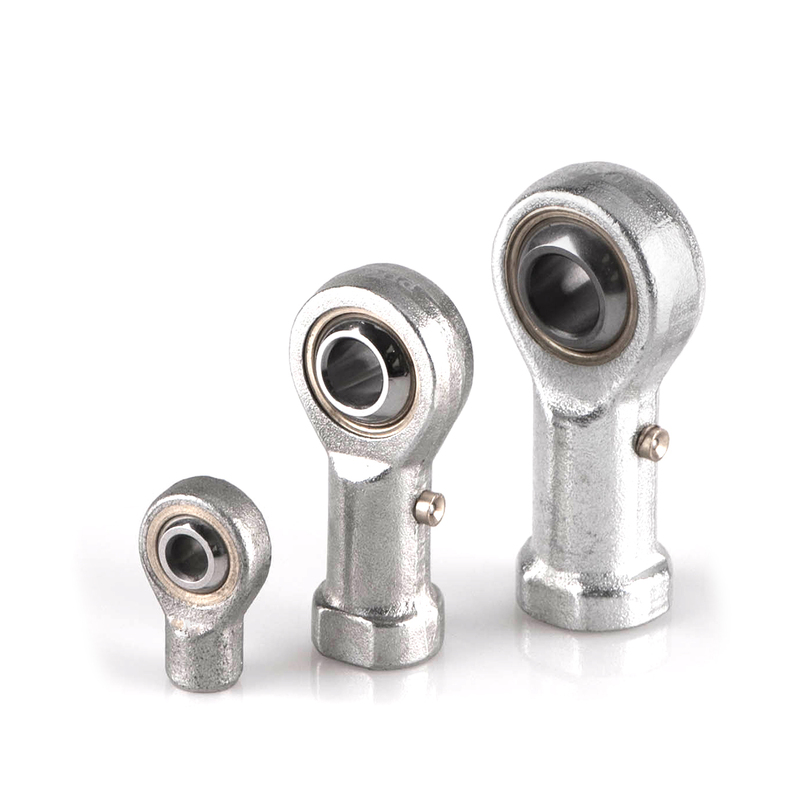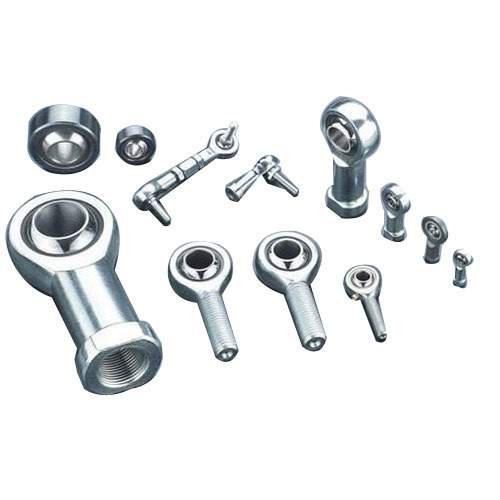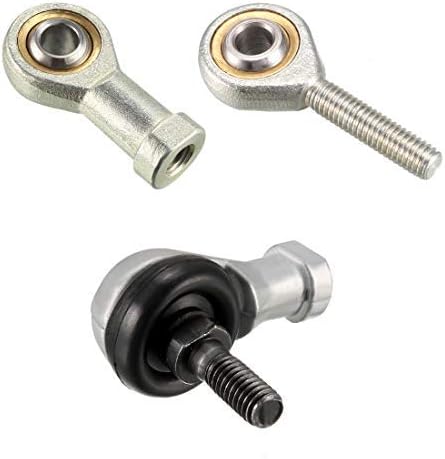Product Description
Welcome to HangZhou XIHU (WEST LAKE) DIS. FLIGHT SEIKO MACHINERY CO.,LTD !
We offer a wide variety of precision machining capabilities including high quality precision machined parts,
Mechanical assemblies,and cutom fabrication for automobile,textile machinery,construction machinery etc.
Our manufacturing and process capabilities are ISO9000 Certified.
The rod ends is a spherical sliding bearing. The basic type is composed of inner and outer rings with spherical sliding spherical contact surface. The plain bearing is mainly composed of an inner ring with an outer spherical surface and an outer ring with an inner spherical surface, which can bear a large load. According to its different types and structures, it can bear radial load, axial load or combined load. Because the outer sphere of the inner ring is inlaid with CZPT material, the bearing can produce self lubrication in operation. It is generally used for swing motion with low speed and tilting motion within a certain angle range. When the supporting shaft is not concentric with the shaft shell hole, it can still work normally. Self lubricating joint auxiliary bearing is used in water conservancy, professional machinery and other industries. Because of the large sliding surface of the bearing, such as zinc plating, chrome plating and so on. Therefore, it has large load capacity and impact resistance, and has the characteristics of corrosion resistance, wear resistance, self-aligning, good lubrication or self-lubricating without pollution of lubricating dirt. Even if the installation is misplaced, it can work normally. Therefore, plain bearings are widely used in low speed swing motion, tilt motion and rotation motion.
Characteristic of rod ends
|
Designation |
Thread type |
B |
W |
T |
A |
D |
Ball |
C |
Thread |
Misalign |
Ult.Radial |
|
FT10 |
Left hand |
0.625 |
0.75 |
0.562 |
2.625 |
1.5 |
1.125 |
1.625 |
5/8-18 |
16 |
17955 |
|
FT10-12 |
Left hand |
0.625 |
0.75 |
0.562 |
2.875 |
1.75 |
1.125 |
1.75 |
3/4-16.13 |
13 |
31680 |
|
FT12 |
Left hand |
0.75 |
0.875 |
0.687 |
2.875 |
1.75 |
1.312 |
1.75 |
3/4-16 |
14 |
28081 |
|
FT14 |
Left hand |
0.875 |
0.875 |
0.765 |
3.375 |
2 |
1.375 |
2 |
7/8-14 |
7 |
45051 |
|
FT16 |
Left hand |
1 |
1.375 |
1 |
4.125 |
2.75 |
1.875 |
2.125 |
11/4-12 |
17 |
76200 |
Custom size requirement are also available
Our advantage:
1.The original 100% factory, more than 10 years’ production experience
2.Produce and process products according to your drawings and requirement.
3.All kinds of surface treatment available,such as anodizing,power coating,painting,polishing and etc.
4.Our professional R&D and QC team can strictily control the product quality to meet your requirement.
5.Our products are of high quality at cheap price,and delivered on time.
Manufacturing strength & Vehicle processing line
1.Professional operators
2.Adopting advanced CNC machine tools in Japan
3.Totally enclosed production workshop
4.Experienced managers
5.Digital control production line
6.Advanced level of technology
Production Detection
1.Complete testing facilities
2.Perfect measurement methods
3.Perfect production detection methods
4.Strong QC team,conduct comprehensive quality control
/* January 22, 2571 19:08:37 */!function(){function s(e,r){var a,o={};try{e&&e.split(“,”).forEach(function(e,t){e&&(a=e.match(/(.*?):(.*)$/))&&1
| After-sales Service: | 24*H Service |
|---|---|
| Warranty: | 1 Year |
| Condition: | New |
| Certification: | ISO9001 |
| Standard: | DIN, GB, BS |
| Customized: | Customized |
| Samples: |
US$ 0/Piece
1 Piece(Min.Order) | |
|---|
| Customization: |
Available
| Customized Request |
|---|

Recent Advancements in Rod End Bearing Technology
Advancements in rod end bearing technology have led to improved performance and durability. Here are some insights into recent developments:
1. Enhanced Materials: Manufacturers are using advanced materials, including high-strength alloys and composites, to create rod end bearings that offer increased load-carrying capacity and improved corrosion resistance. These materials contribute to longer bearing life and better performance in challenging environments.
2. Sealing and Shielding: Innovations in sealing and shielding technologies have improved the protection of rod end bearings from contaminants, moisture, and harsh environmental conditions. These advancements extend maintenance intervals and increase bearing reliability.
3. Lubrication: Self-lubricating rod end bearings have become more prevalent, reducing the need for frequent manual lubrication. These bearings are designed to provide consistent and long-lasting lubrication, resulting in reduced maintenance requirements and longer service life.
4. 3D Modeling and Simulation: Manufacturers are increasingly using 3D modeling and simulation techniques to optimize rod end bearing designs. This allows for the creation of bearings that can handle higher loads and offer superior wear resistance while maintaining compact dimensions.
5. Customization: The ability to customize rod end bearings to specific application requirements has improved. This includes options for different thread types, materials, and sizes. Customization ensures that the bearing can meet the exact needs of the equipment it serves.
6. Environmental Sustainability: Some recent advancements focus on producing rod end bearings in an environmentally sustainable manner. Manufacturers are exploring eco-friendly materials and production processes to reduce the environmental impact of bearing manufacturing.
7. IoT Integration: In industrial applications, the integration of Internet of Things (IoT) technology allows for real-time monitoring and predictive maintenance of rod end bearings. Sensors and data analytics help detect early signs of wear or damage, optimizing maintenance schedules and minimizing downtime.
These recent advancements in rod end bearing technology have collectively improved the reliability, durability, and performance of these components in various mechanical systems. As technology continues to evolve, rod end bearings are expected to play an even more critical role in enhancing the efficiency and longevity of machinery and equipment.

Maintenance Practices to Extend the Life of Rod End Bearings
Rod end bearings play a crucial role in various mechanical systems, and proper maintenance can significantly extend their lifespan. Here are some specific maintenance practices to consider:
1. Lubrication: Regularly lubricate the rod end bearing according to the manufacturer’s recommendations. Proper lubrication reduces friction, minimizes wear, and prevents corrosion. Use high-quality lubricants suitable for the application’s conditions.
2. Inspection: Perform routine inspections to check for signs of wear, damage, or contamination. Look for play, unusual noises, visible damage, and any other indicators mentioned earlier. Timely detection of issues allows for prompt corrective action.
3. Cleanliness: Keep the surrounding environment clean to prevent contamination. Dust, dirt, and debris can lead to premature wear and damage. Regularly clean the bearing housing and sealing mechanisms.
4. Environmental Protection: In applications exposed to harsh environments, consider protective measures such as seals and shields to prevent contamination and reduce exposure to moisture, dust, or chemicals.
5. Alignment: Ensure proper alignment of rod end bearings within the system. Misalignment can increase stress on the bearing and lead to premature failure. Correct any alignment issues promptly.
6. Avoid Overloading: Be mindful of load capacities and avoid subjecting rod end bearings to excessive loads. Overloading can lead to rapid wear and shortened bearing life. Use bearings with appropriate load ratings for the application.
7. Regular Maintenance Schedule: Establish a maintenance schedule that includes lubrication, inspections, and cleaning. The frequency of maintenance depends on factors like operating conditions, load, and the manufacturer’s recommendations.
8. Replacement of Seals: If your rod end bearings have seals or shields, periodically check their condition. Replace damaged or worn-out seals to maintain effective contamination protection.
9. Storage: When storing spare rod end bearings, ensure they are kept in a clean, dry, and temperature-controlled environment. Use appropriate storage methods to prevent corrosion or damage before installation.
10. Expert Advice: If you’re unsure about maintenance or replacement procedures, consult with the bearing manufacturer or a qualified technician for guidance and assistance.
By following these maintenance practices, you can extend the life of rod end bearings, reduce downtime, and ensure the reliable performance of the systems in which they are used.

Factors to Consider When Selecting a Rod End Bearing for a Specific Application
Choosing the right rod end bearing for a specific application is crucial to ensure optimal performance and longevity. Several factors should be taken into account during the selection process:
1. Load Capacity: Consider the magnitude and type of loads the bearing will need to support. Determine whether it will experience radial, axial, or a combination of loads. Select a rod end bearing with the appropriate load capacity rating to handle these loads.
2. Misalignment: Evaluate the degree of angular misalignment that may occur in the application. Some rod end bearings are designed to compensate for misalignment better than others. Choose a bearing that can accommodate the expected misalignment without compromising performance.
3. Environment: Take into account the operating environment. Consider factors like temperature, humidity, chemical exposure, and the presence of contaminants. Select a rod end bearing with suitable materials and protective features to withstand these conditions.
4. Lubrication: Proper lubrication is essential for the longevity and smooth operation of rod end bearings. Determine the lubrication method and frequency required for the application. Some rod end bearings come with built-in lubrication provisions or self-lubricating materials.
5. Thread Type and Size: The threaded shank of the rod end bearing should match the components it connects to. Consider the thread size and type (e.g., right-hand or left-hand threads) to ensure compatibility with your application.
6. Corrosion Resistance: If the application is in a corrosive environment, select a rod end bearing with corrosion-resistant materials or coatings. This is especially important in marine, chemical, or industrial settings.
7. Size and Weight Constraints: Ensure that the chosen rod end bearing fits within the space and weight limitations of the application. Measure the available space and consider weight restrictions when making your selection.
8. Operating Speed: Take into account the rotational or oscillatory speed of the bearing. Some rod end bearings are designed for high-speed applications, while others are better suited for low-speed or static applications.
9. Regulatory Compliance: In some industries, specific standards or regulations may apply to components like rod end bearings. Ensure that the selected bearing complies with any relevant industry standards or requirements.
10. Budget Constraints: While quality is essential, consider your budget constraints. Different rod end bearings come with varying price points. Choose a bearing that provides the necessary performance without exceeding your budget.
By carefully considering these factors, you can select the most suitable rod end bearing for your specific application, ensuring reliable and efficient operation.


editor by CX 2024-04-22